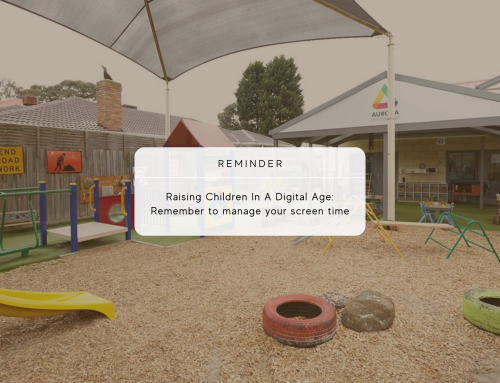At Aurora, we integrate mindfulness into all parts of our daily routine. During mealtimes, our educators help children become more aware of what they are eating through mindfulness exercises and conversations.
What Is Mindful Eating?
Mindful eating is the practice of bringing focus to meals and the food we eat. It includes pausing to notice the texture, smell and taste of a particular food. It includes appreciating how a dish is plated or the colours of ingredients.
Mindful eating also includes being aware of cravings, our levels of hunger and the food we’re choosing to address our body’s needs. While eating, we also think about where our food has come from and how the food makes us feel.
Why Practice Mindful Eating?
Studies have found mindful eating can help you lose weight, improve the symptoms of Type II diabetes and reduce overeating and binge eating. When children practice mindful eating, they begin to build a healthy relationship with food and understand how to make healthy food choices. They pay attention to their bodies and learn to eat when they are hungry. By being attentive to how food makes them feel, they also consciously experience the benefits of healthy foods.
Mindful eating is also a great way to help children understand the mindfulness concept as a whole. As they use all five of their senses to focus on a particular food, they learn how to bring their attention into the present moment. Their ability to practice mindfulness grows and they bring the ability to other areas of their lives as well.

There are several ways to bring mindfulness into children’s mealtimes.
Sit Down and Slow Down
We’re always pressed for time and so, very often, we have our meals on the go; on the drive to Kinder or while walking to a playdate.Plan your day so that your family sits down at the table for at least one meal a day. Then, encourage your child to chew each piece of food slowly, asking them to think about the taste, texture and the smell of the food.
Practice Gratitude
Before beginning to eat, take a moment to show gratitude for the food you are about to eat. Ask your child where the food has come from and think about who may have helped make it. Practicing gratitude will help you and your children begin the meal with a deeper sense of contentment and respect for the food.

Use The Five Senses
Ask your child to use all five of their senses while eating. What sound do they hear when they bite into an apple? What color is the spaghetti? Is a lychee prickly or smooth?
These discussions will help improve your child’s communicative and investigative skills as well as help them focus on what they are eating.
No Technology
Allow your family to focus entirely on the meal; switch of the television, put away your iPhones, iPads and what have you. Eliminating all distractions makes it easier to focus on the experience of eating and on the people you’re eating with.
Listen – And Talk
As your child to listen to their bodies as they eat. Do they need one more piece of pie or is their body telling them they’re full?
Through the meal, take the time to have deeper conversations – about the food, as well as about your child’s day. Mindful eating allows us to bring a deeper level of focus to our mealtime conversations.
After meals, ask them to recognize how certain foods may have made them feel. Did, for instance, having a bowl of soup make them feel warmer during the winter? Did the apple make them feel more energetic?

By having regularly mindful meals, mindful eating will gradually become a habit that your children will carry with them as they grow older and start making their own food choices.
Have a trip to Aurora Early Child Education Centres:





